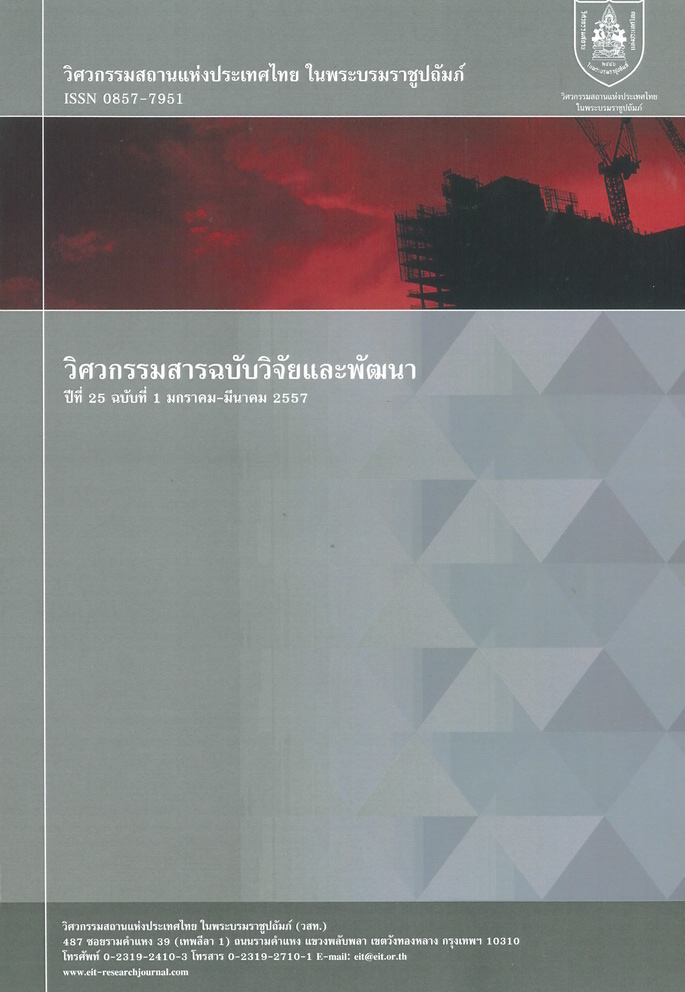Development of Water Management in Paddy Fields to Reduce Methane Emission
Main Article Content
Abstract
จากงานวิจัยที่ผ่านมาในปี 2549 คณะผู้วิจัยได้ทำการศึกษาการจัดการน้ำในนาข้าวเพื่อลดผลกระทบสิ่งแวดล้อม ผลปรากฏว่าที่ระดับท่วมขังในนาข้าวสูงกว่าและนานกว่าส่งผลต่อปริมาณก๊าซมีเทน (CH4) มากกว่า ทั้งนี้การทำนาแบบดั้งเดิมส่งผลกระทบมากที่สุดและแบบเปียกสลับแห้งส่งผลกระทบน้อยที่สุดคือ เกิดมีเทนในนาข้าวน้อยสุด งานวิจัยนี้มุ่งเน้นการปรับปรุงและประยุกต์ผลการวิจัยเพื่อทดสอบใช้ในการจัดการน้ำในนาข้าวจริงของเกษตรกร ผลการศึกษาพบว่า การบริหารจัดการน้ำในนาข้าวแบบเปียกสลับแห้งประยุกต์เป็นวิธีการบริหารจัดการน้ำที่สามารถใช้งานได้ดี โดยสามารถลดการปลดปล่อย CH4 ใน นาปีและนาปรังได้ถึง 80-82% และ CH4 จะเกิดขึ้น เมื่อค่า Eh อยู่ระหว่าง -67 ถึง -347 mV นอกจากนี้การคาดการณ์การแพร่กระจายของ CH4ในนาปรังของภาคตะวันตกด้วยแบบจำลอง DNDC พบว่า การบริหารจัดการน้ำในนาข้าวแบบเปียกสลับแห้งประยุกต์สามารถลดการแพร่กระจายของ CH4 ได้ถึง 76% และลดการปลดปล่อย CH4 เหลือเพียง 0.029 เทระกรัม/ปี
In 2006, the authors conducted a research focused on water management in paddy fields to reduce environmental impacts. It was found that higher and longer flooding period of paddy field increased methane (CH4) emission such that the traditional irrigation promoted the highest impacts on CH4 emission, while the combination of shallow water depth with drying period showed the lowest impacts. This paper focused on improvement and application of water management in irrigated farm at the real field condition such that paddy fields were irrigated only when they were dry to reduce methane emission. The result showed that applied wet and dry water management was an acceptable and operational water management method. It decreased CH4 emission up to 80-82% both in wet and dry seasons. CH4 emission is maximum when Eh is between -67 to -347 mV. In addition, CH4 emission prediction in the Western region of Thailand using DNDC model showed that the application of applied wet and dry water management could reduce CH4 emission by 76% and total emission of CH4 emission could reduce from 0.126 to 0.029 Tg/year.
Article Details
The published articles are copyright of the Engineering Journal of Research and Development, The Engineering Institute of Thailand Under H.M. The King's Patronage (EIT).


